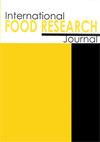紫色复合果酒的工艺探索及抗氧化活性测定
IF 1
4区 农林科学
Q4 FOOD SCIENCE & TECHNOLOGY
引用次数: 1
摘要
在加工过程中,紫椒和紫玉米虽然富含花青素和其他营养物质,但利用率却很低。因此,关注其处理的研究对于解决其未充分利用的问题至关重要。以紫椒和玉米为原料,配制了复合果酒。采用单因素试验和响应面设计对发酵工艺参数进行优化。以复合果酒的感官特性为指标。通过对1,1-二苯基-2-苦味酰肼基自由基(DPPH·)和羟基自由基(·OH)的清除率,评价了紫色复合果酒的抗氧化能力。以72.0%紫椒汁和28.0%紫玉米汁(初始含糖量为23.3%)混合,接种6.2%酿酒酵母,23℃发酵7.8 d,得到感官分数为94.2,酒精体积分数为8.6%的紫色复合果酒。所制得的紫色复合果酒具有典型的和谐果香和醇厚的口感。紫色复合果酒中花青素含量为1.38±0.14 mg/mL,对DPPH·和·OH的半抑制浓度(IC50)值分别为51.31和49.08 mg/mL。优化后的发酵工艺可为紫椒和玉米的工业化利用提供理论依据。本文章由计算机程序翻译,如有差异,请以英文原文为准。
Technological exploration and antioxidant activity determination of purple compound fruit wine
When it comes to processing, purple pepper and purple corn are poorly utilised even though they are rich in anthocyanins and other nutrients. Therefore, studies focusing on their processing are vital for resolving their underutilisation. In the present work, purple pepper and corn were used to prepare a compound fruit wine. The fermentation process parameters were optimised using single factor tests and response surface design. The sensory characteristics of the compound fruit wine were used as an indicator. The antioxidant potential of the purple compound fruit wine was also assessed using 1,1-diphenyl-2-picrylhydrazyl radical (DPPH·) and hydroxyl radical (·OH) scavenging rates. A purple compound fruit wine with a sensory score of 94.2 and 8.6% alcohol by volume was obtained using a combination of 72.0% purple pepper juice and 28.0% purple corn juice (with an initial sugar content of 23.3%), followed by inoculation with 6.2% Saccharomyces cerevisiae and fermentation for 7.8 d at 23°C. The resulting purple compound fruit wine had a typical harmonious fruit aroma and a mellow taste. Furthermore, the content of anthocyanins in purple compound fruit wine was 1.38 ± 0.14 mg/mL, and the half inhibitory concentration (IC50) values against DPPH· and ·OH were 51.31 and 49.08 mg/mL, respectively. This optimised fermentation process could serve as a theoretical basis for the industrial utilisation of purple pepper and corn.
求助全文
通过发布文献求助,成功后即可免费获取论文全文。
去求助
来源期刊

international food research journal
Agricultural and Biological Sciences-Food Science
CiteScore
1.40
自引率
0.00%
发文量
75
期刊介绍:
The International Food Research Journal (IFRJ) publishes papers in English, six (6) issues a year with the coverage of:
Food Science and Technology
Nutrition and Dietetics
Agriculture, multidisciplinary
Chemistry, multidisciplinary
The scope of the Journal includes:
Food Science, Food Technology and Food Biotechnology
Product Development and Sensory Evaluation
Food Habits, Nutrition, and Health
Food Safety and Quality
Food Chemistry, Food Microbiology, Food Analysis and Testing
Food Engineering
Food Packaging
Food Waste Management
Food Entrepreneur
Food Regulatory
Post-Harvest Food Management
Food Supply Chain Management
Halal Food and Management
 求助内容:
求助内容: 应助结果提醒方式:
应助结果提醒方式:


